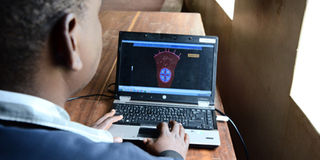Now’s a good time to embrace e-learning

The school lockdown has just shown us how important e-learning can be and why we need to move in that direction. Photo by George Katongole
Online learning in Uganda, has been picking pace in some secondary schools but this is largely limited to urban schools, which have electricity, more access to computers and the Internet. A survey conducted by UNESCO in 2007 on e-learning in Africa shows that secondary school courses provided under e-learning covered 22 per cent of all subjects.
Winnie Mutesi is one of the many parents who face uncertain times after the school term was cut short by government. This was done as a measure to prevent spread of coronavirus that has wreaked havoc in many parts of the world.
On Wednesday, President Museveni directed that all schools close for 32 days because of the coronavirus pandemic.
Even if the President said the ban would last a month, no one knows for sure whether by that time, coronavirus will not be a problem anymore. This poses a problem as to how learners can continue with their studies from home.
Video classes
Noah Lufaafa of Alpha Edu-care says video classes are a good option.
“Most people are not used to this kind of education. I recently tried pitching the idea to schools but the interest was low,” Lufaafa, who makes a living as a music teacher, says.
This low interest is likely to change following the closure of schools. Lufaafa says by end of last week, he had received more than 30 orders and countless inquiries on both Facebook and WhatsApp about his Mathematics, Science and English videos.
How it is done
These classes are offered on DVDs and MP4 formats making them an effective tool. MP4 formats can be used on laptops, phones and TVs.
This comes with an added advantage of tests and examinations.
Internet Connectivity
As coronavirus turns online conveniences into daily necessities, people, most of whom live in rural areas, have been cut off from their regular lives, especially when it comes to education.
According to a research titled, “The state of ICT in Uganda” by Alison Gillwald, Onkokame Mothobi, Ali Ndiwalana and Tusu Tusubira, Uganda has a huge urban–rural gap in Internet use of 70 per cent, where only nine per cent of Ugandans living in rural areas have access to the Internet and about a third (30 per cent) of urban area dwellers use it.
This therefore means considering e-learning for students might be for only a few who have access to connectivity.
Joseph Segawa, the deputy head teacher Buyamba SS says the school had to hastily prepare holiday packages for students in candidate classes.
“In rural areas, many parents cannot afford the luxuries of technology and we had to find cheaper alternatives,” Segawa says.
He adds that there has been a practice by some parents to hire teachers during holidays to help their children but that has been rendered useless now.
“No parents would risk an outsider coming into their home,” he said.
Lessons on TV and radio
Segawa thinks that public televisions can be of help in this crisis by allocating study time for all children. “TV managers can think of inviting the best teachers they know to offer lessons to learners.
This is a time when the media can be of more help,” Segawa reasons.
Youtube
YouTube is one place where various classes can be held. For some students, online learning means switching to something unusual.
“It is quite a distraction. I have been studying for SAT exams and I will tell you it is a mess. I was used to instruction by the teachers and I find online studying so complex,” Sadam Masereka says.
What next?
The lockdown comes at a time when schools were preparing to register candidates for Uneb examinations. This is the time most schools rush to complete the curriculum and then focus on revision in Term Two.
Segawa says if the break last only a month, the holiday would be shortened to allow more school time when the students return.
Lufaafa says it is time the local curriculum is aligned with the latest technologies. “This situation has just shown us how important e-learning can be and why we need to move in that direction,” he says.
Other learning solutions
Unesco has outlined distance learning solutions and platforms to help parents, teachers, schools and school systems facilitate student learning and provide social caring and interaction during periods of school closure across the globe.
Most of the highlighted solutions are free and several support multiple languages. They include, digital learning management systems, systems purpose-built for mobile phones, systems with strong offline functionality, Massive Open Online Course Platforms, self-directed learning content, mobile reading applications, collaboration platforms that support live-video communication as well as tools to create of digital learning content.
Advantages
eLearning accommodates everyone’s needs. The online method of learning is best suited for everyone. This digital revolution has led to remarkable changes in how the content is accessed, consumed, discussed, and shared.
Online educational courses can be taken up by office goers and housewives too, at the time that suits them. Depending on their availability and comfort, many people choose to learn at weekends or evenings.
Lectures can be taken any number of times
Unlike classroom teaching, with online learning you can access the content an unlimited number of times.
Quick delivery of lessons
eLearning is a way to provide quick delivery of lessons. As compared to traditional classroom teaching method, this mode has relatively quick delivery cycles. Due to the wide set of benefits it gives to students, eLearning has become quite popular and appreciated among students all over the world. (Source: elearningindustry.com)




